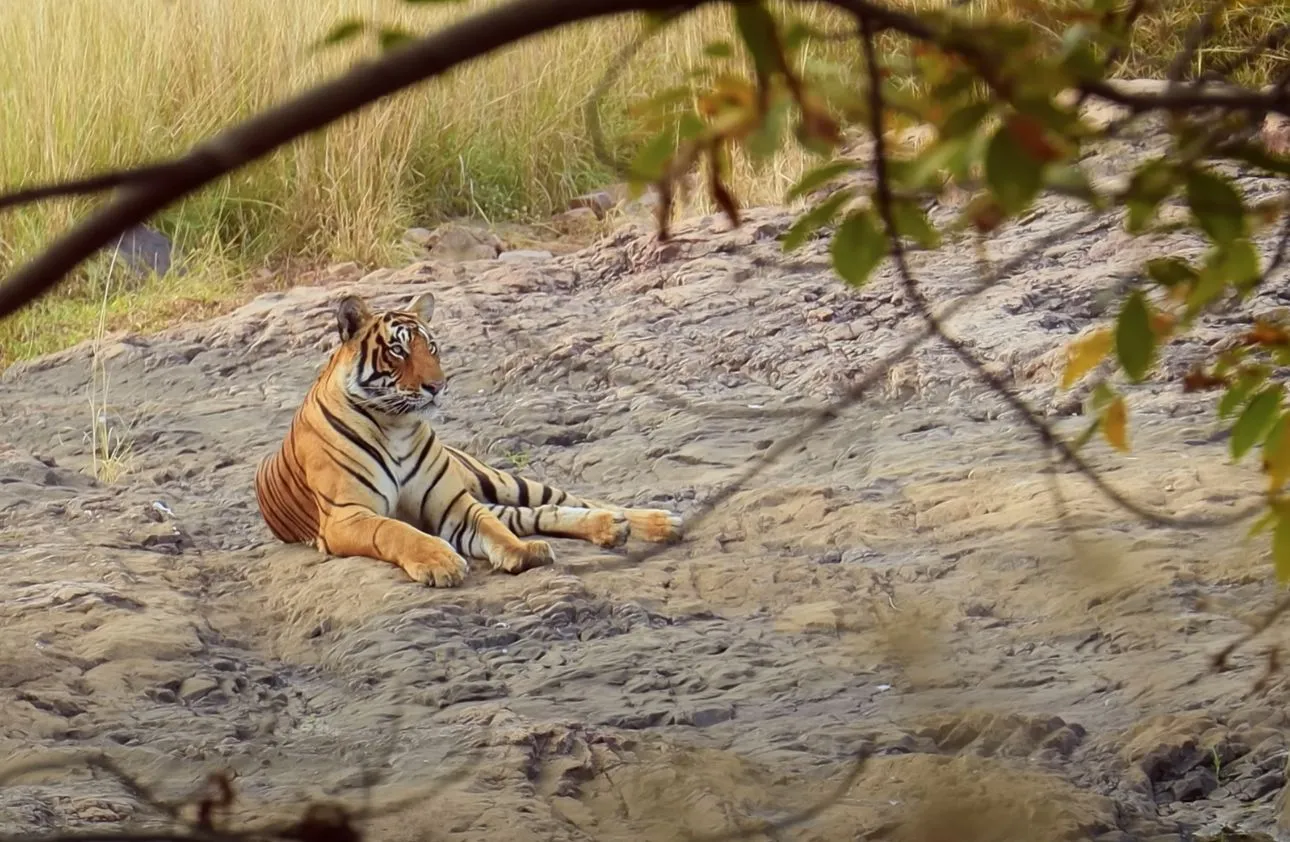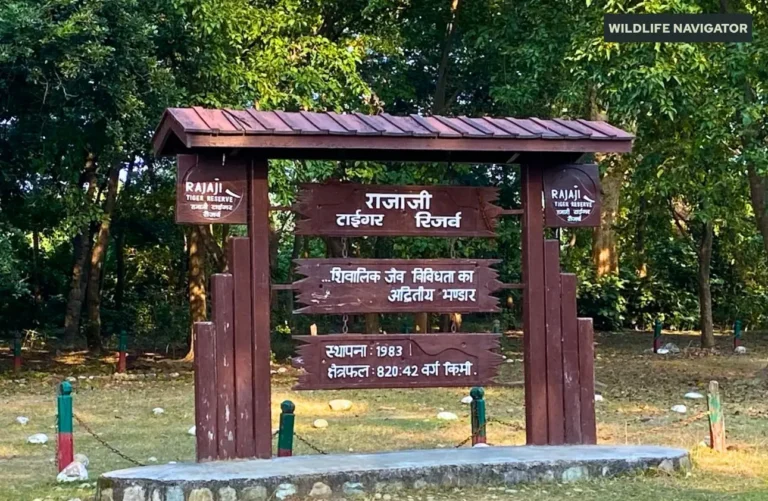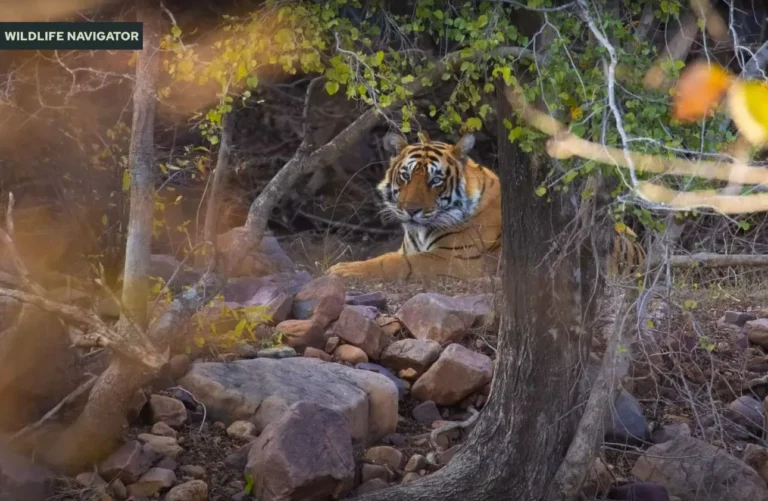Royal Bengal Tiger – The Pride of Indian Wildlife

The Royal Bengal Tiger (Panthera tigris tigris) is not just an animal—it is a living emblem of power, grace, and resilience. Known for its striking orange coat with bold black stripes, piercing eyes, and unmatched hunting skills, this magnificent big cat holds a special place in both India’s wilderness and its cultural heritage. It is no surprise that the Royal Bengal Tiger is honoured as the national animal of India, symbolizing courage and strength.
With an estimated population of around 3,000 tigers in India (as per the 2022 tiger census), the country is home to nearly 75% of the world’s tiger population, making it the most significant stronghold for this endangered species. From the dense mangrove swamps of the Sundarbans to the dry deciduous forests of Ranthambore, and from the sal-rich woodlands of Jim Corbett to the lush landscapes of Kaziranga and Manas National Park, the Bengal tiger thrives across diverse ecosystems.
Beyond its ecological role as a top predator that maintains balance in the food chain, the tiger is also deeply woven into Indian folklore, mythology, and modern conservation efforts. Today, spotting a Royal Bengal Tiger in the wild is one of the most thrilling experiences for wildlife enthusiasts and travellers alike—a moment that leaves visitors with goosebumps and a lifelong memory.
The journey to understand this majestic creature takes us through its appearance, behaviour, habitat, threats, and the global fight for its survival—a journey worth exploring in detail.
Physical Characteristics of the Royal Bengal Tiger
The Royal Bengal Tiger is among the most powerful and majestic of all big cats. Its appearance is a perfect balance of beauty and ferocity, making it instantly recognisable and admired across the globe.
Size and Appearance
Royal Bengal Tigers are one of the largest tiger subspecies in the world. Adult males usually weigh between 180–260 kg (400–570 lbs) and measure 2.7–3.1 meters (9–10 ft) in length, including the tail. Females are smaller, typically weighing between 100–160 kg (220–350 lbs) and measuring about 2.4–2.6 meters (8–8.5 ft). Despite their massive size, these cats are incredibly agile and stealthy hunters.
Their coat is a rich orange to yellow colour, adorned with black vertical stripes that act as camouflage in the dappled light of forests and grasslands. The underbelly, inner limbs, and cheeks are generally white, giving them a sharp contrast and striking appearance.
Distinctive Features
- Stripes: Each tiger’s stripe pattern is unique, much like human fingerprints. This helps scientists identify individuals in the wild.
- Eyes: Tigers have round pupils with a golden or amber iris. Their vision at night is six times stronger than that of humans, making them efficient nocturnal hunters.
- Teeth & Claws: Equipped with 7.5 cm (3 in) long canine teeth and sharp retractable claws, they are apex predators designed for strength and precision.
- Roar: The roar of a Bengal tiger can be heard up to 3 kilometres (2 miles) away, used to mark territory and communicate with other tigers.
Male vs. Female Tigers
Males are larger, heavier, and more territorial, often controlling large ranges that overlap with multiple females. Females, while smaller, play a crucial role in rearing cubs and ensuring the survival of the species. A female tiger usually raises her cubs alone, fiercely protecting them for the first 2–3 years of their lives.
Habitat and Distribution
The Royal Bengal Tiger thrives across a wide variety of landscapes, adapting to environments that range from dense forests to mangroves and grasslands. Their adaptability is one of the key reasons they continue to survive, despite growing human pressure and habitat loss.
Natural Habitat
Bengal tigers prefer tropical and subtropical forests, grasslands, and mangrove ecosystems. Their ideal habitat includes:
- Dense vegetation for cover during hunts.
- Abundant prey base such as deer, wild boar, and gaur.
- Access to water sources, since tigers love water and often cool off in rivers, ponds, or swamps.
These habitats not only provide camouflage but also support the rich biodiversity needed for the tiger’s survival.
Global Distribution
The Bengal Tiger (Panthera tigris tigris) is found across four countries in South Asia:
- India – Home to nearly 75% of the world’s Bengal tigers, with over 50 designated tiger reserves in India.
- Bangladesh – Famous for the Sundarbans mangroves, where swimming tigers have adapted to tidal estuaries.
- Nepal – Tigers roam the Terai Arc Landscape, particularly Chitwan and Bardia National Parks.
- Bhutan – A smaller population exists in forested valleys and foothills.
Outside these regions, Bengal tigers are not naturally found in the wild, though they may exist in captivity worldwide.
Major Tiger Reserves in India
India is the true stronghold of the Royal Bengal Tiger. Some of the most renowned reserves include:
- Sundarbans Tiger Reserve (West Bengal) – Famous for swimming tigers in mangrove swamps.
- Ranthambore National Park (Rajasthan) – Known for its photogenic tigers around ancient ruins.
- Bandhavgarh National Park (Madhya Pradesh) – Holds one of the highest densities of tigers.
- Jim Corbett National Park (Uttarakhand) – India’s first tiger reserve, rich in sal forests.
- Kanha Tiger Reserve (Madhya Pradesh) – Inspiration for Kipling’s Jungle Book.
- Kaziranga National Park (Assam) – Famous for both rhinos and tigers in lush floodplains.
These reserves are some of the best places to see tigers in the wild, and each offers a unique safari experience.
Behaviour and Lifestyle
The Royal Bengal Tiger is not only a symbol of strength but also a fascinating predator with unique behavioural traits. Its lifestyle reflects its solitary yet powerful presence in the wild.
Hunting and Diet
The Royal Bengal Tiger is an apex predator at the top of the food chain. It primarily hunts at night (nocturnal), relying on stealth and explosive power.
- Diet: Consists of medium to large prey such as spotted deer (chital), sambar deer, wild boar, gaur (Indian bison), and occasionally young elephants or rhinos. They also prey on smaller animals like monkeys, hares, and birds when larger prey is scarce.
- Hunting Style: Tigers are ambush hunters. They stalk silently, getting as close as possible before charging with a sudden burst of speed. A powerful bite to the throat or neck suffocates the prey.
- Success Rate: Only about 1 in 10 hunting attempts succeed, which is why tigers cover large territories in search of food.
- Consumption: An adult tiger can eat up to 40 kg (90 lbs) of meat in one meal, though they usually consume 10–15 kg at a time.
Social Behavior
Unlike lions, tigers are solitary animals. Each adult maintains a well-defined territory marked with scent markings, urine sprays, and scratch marks on trees.
- Males: Hold larger territories that may overlap with multiple females. They are generally intolerant of other males.
- Females: Occupy smaller ranges, often overlapping with their mother or sisters, and are more tolerant of family members.
- Communication: Tigers communicate through roars, growls, scent markings, and even body language like tail flicks or ear positioning.
Reproduction and Lifespan
The survival of the species depends heavily on the female tiger’s role as a mother.
- Mating Season: Can occur year-round, though peak breeding often happens between November and April.
- Gestation Period: About 100–110 days.
- Cubs: A litter usually has 2–4 cubs. Sadly, due to high infant mortality, only 1–2 typically survive to adulthood.
- Mother’s Role: The female raises cubs alone, teaching them hunting skills until they become independent around 2–3 years of age.
- Lifespan: In the wild, Bengal tigers live around 10–15 years, while in captivity, they can live up to 20 years.
Cultural and Mythological Significance
The Royal Bengal Tiger is more than a magnificent animal—it is an enduring symbol of strength, courage, and power in Indian culture and mythology. Its presence in art, folklore, and spiritual beliefs reflects how deeply it is woven into the cultural fabric of South Asia.
In Indian Mythology and Folklore
- In Hindu mythology, the tiger is closely associated with Goddess Durga, who is often depicted riding a tiger (or lion) as a symbol of fearlessness, justice, and protection against evil forces.
- Folktales across rural India celebrate the tiger as a guardian of forests, often portraying it as both a protector and a threat.
- In tribal traditions, the tiger is revered as a forest deity and respected as the ultimate ruler of the jungle.
As India’s National Animal
In 1973, India officially declared the Royal Bengal Tiger as its National Animal, replacing the lion. This decision symbolised the tiger’s widespread presence across the country and its vital role in ecological balance. It also marked the beginning of Project Tiger, a landmark conservation initiative to save the species from extinction.
Global Recognition
- The Royal Bengal Tiger has become a global icon of wildlife conservation, often featured in campaigns by WWF, IUCN, and other organisations.
- It is also celebrated in literature, documentaries, and photography, where it represents the untamed spirit of nature.
- Even beyond India, the tiger is a symbol of power and majesty—making it one of the most recognised and admired animals worldwide.
Symbolism in Modern Times
Today, the image of the Royal Bengal Tiger is used widely in branding, sports teams, and tourism campaigns. From the emblem of the Indian Army regiments to logos of wildlife organisations, the tiger continues to symbolise strength, leadership, and resilience.
Threats to the Royal Bengal Tiger
Despite being a powerful apex predator, the Royal Bengal Tiger is classified as Endangered on the IUCN Red List. Over the past century, its population has declined drastically due to human activity and environmental challenges. While conservation efforts have helped in recent decades, serious threats continue to endanger their survival.
Poaching and Illegal Wildlife Trade
- Tigers are one of the most heavily poached animals in the world.
- Their skin, bones, claws, and whiskers are illegally traded for traditional medicine, ornaments, and trophies.
- International wildlife trafficking networks smuggle tiger parts across borders, especially to Southeast Asia and China, where demand remains high.
- Poaching not only reduces tiger populations but also disrupts breeding cycles and destabilises entire ecosystems.
Habitat Loss and Fragmentation
- Expanding human settlements, agriculture, mining, and infrastructure projects have led to large-scale deforestation and fragmentation of tiger habitats.
- Today, tigers occupy only 7% of their historic range, making them vulnerable to inbreeding and isolation.
- Roads and railways cutting through reserves often lead to accidents and restrict tiger movement.
- Human-wildlife conflict rises as tigers are forced closer to villages, sometimes attacking livestock or even people, which in turn leads to retaliatory killings.
Decline in Prey Population
- Overhunting of deer, wild boar, and other prey species by humans leaves tigers with fewer food options.
- Without sufficient prey, tigers are pushed into conflict situations or face starvation.
Climate Change (The Case of Sundarbans)
- The Sundarbans, home to the only mangrove-inhabiting tigers in the world, face an existential threat due to rising sea levels caused by climate change.
- Increased salinity, cyclones, and erosion are shrinking tiger habitats in this UNESCO World Heritage Site.
- Climate change also increases the unpredictability of prey availability, adding stress to tiger populations.
Other Emerging Threats
- Tourism pressure in popular reserves, if unmanaged, can disturb tiger habitats.
- Diseases spreading from domestic animals to wild species pose hidden dangers.
Conservation Efforts and Success Stories
The fight to save the Royal Bengal Tiger is one of the most ambitious and inspiring conservation stories in the world. From the brink of extinction in the 20th century to a cautious recovery today, India and neighbouring countries have invested heavily in protecting their national treasure.
Project Tiger (Launched in 1973)
- Background: By the early 1970s, India’s tiger population had dropped alarmingly due to poaching and habitat loss.
- Launch: The Indian government introduced Project Tiger in 1973, focusing on creating dedicated reserves where tigers could thrive safely.
- Impact: Starting with 9 reserves, the project now includes over 50 tiger reserves across India, covering more than 70,000 sq. km of protected habitat.
- Result: India’s tiger population has shown a steady increase, making the country home to nearly 75% of the world’s tigers today.
Role of National Parks and Reserves
Protected areas like Ranthambore, Jim Corbett, Bandhavgarh, Sundarbans, and Kanha have become global symbols of tiger conservation. These reserves:
- Provide safe breeding grounds.
- Support eco-tourism, which generates funds for conservation.
- Act as biodiversity hotspots, protecting not only tigers but also prey species and ecosystems.
Community Involvement and Eco-Tourism
- Local communities play a crucial role in tiger protection. Many conservation projects now focus on creating alternative livelihoods (such as eco-tourism jobs, handicrafts, or guiding) so villagers rely less on forest resources.
- Eco-tourism has transformed reserves into sustainable travel destinations. Responsible safaris create awareness while funding forest protection.
Global Collaboration
- International organisations like WWF, IUCN, and Global Tiger Forum (GTF) work with India, Nepal, Bhutan, and Bangladesh to protect Bengal tigers.
- In 2010, 13 tiger-range countries pledged to double the global tiger population by 2022 in the Tx2 initiative. India has been one of the biggest contributors toward this goal.
Success Stories
- Ranthambore Tigers: Once dwindling, this park now thrives with famous tigers like Machhli, who became symbols of conservation success.
- Nepal: In 2022, Nepal almost doubled its tiger population since 2010—a rare global conservation win.
- India’s Census 2022: Showed a rise in tiger numbers to 3,167 tigers, making India the safest stronghold for Bengal tigers worldwide.
Where to Spot the Royal Bengal Tiger in India
For wildlife enthusiasts, nothing compares to the thrill of spotting a Royal Bengal Tiger in its natural habitat. India, with its vast network of tiger reserves, offers some of the best safari experiences in the world. Each park has its own unique landscapes, stories, and tiger populations, making every safari adventure different.
Here are the top national parks and reserves in India where you have the best chance to encounter this majestic predator:
Ranthambore National Park (Rajasthan)
- Famous for its historic ruins and dramatic landscapes.
- Tigers here are bold and often spotted near lakes, palaces, and forts.
- Known for iconic tigress Machhli, who became the “Queen of Ranthambore.”
- Best Time: October–June (summer sightings are frequent near water bodies).
Bandhavgarh National Park (Madhya Pradesh)
- Holds one of the highest tiger densities in India, giving visitors excellent sighting opportunities.
- Also home to the Bandhavgarh Fort and rich historical relics.
- Best Time: March–June for higher sighting chances.
Jim Corbett National Park (Uttarakhand)
- Established in 1936, it is India’s first national park and the birthplace of Project Tiger.
- Offers jeep safaris and elephant safaris in diverse terrains like grasslands, river belts, and sal forests.
- Best Time: November–April.
Sundarbans Tiger Reserve (West Bengal)
- UNESCO World Heritage Site, known for its mangrove forests and water-adapted swimming tigers.
- Tigers here are elusive and have adapted to tidal estuaries.
- Safari is by boat, giving a completely different experience.
- Best Time: November–February.
Kanha Tiger Reserve (Madhya Pradesh)
- Inspiration for Rudyard Kipling’s The Jungle Book.
- Known for vast meadows and sal forests where tigers roam freely.
- Also home to barasingha (swamp deer), an endangered species.
- Best Time: February–June.
Kaziranga National Park (Assam)
- World-famous for its one-horned rhinoceros, but also a thriving tiger habitat.
- Offers sightings in tall elephant grasslands and wetlands.
- Best Time: November–April.
Other Notable Reserves
- Tadoba (Maharashtra) – Known for regular tiger sightings and stunning forest trails.
- Pench (Madhya Pradesh/Maharashtra) – The setting for Kipling’s Mowgli stories.
- Periyar (Kerala) – Southern India’s tiger stronghold.
Safari Tips for Tiger Spotting
- Choose early morning or late afternoon safaris for the best chance.
- Summer months (April–June) increase sightings as tigers gather near water sources.
- Be patient: tiger spotting is about luck, persistence, and respect for the wild.
- Always book safaris through authorised guides and forest departments.
Interesting Facts About the Royal Bengal Tiger
The Royal Bengal Tiger is full of surprises. Beyond its fearsome reputation as a top predator, this magnificent cat has fascinating traits that showcase its adaptability, intelligence, and uniqueness. Here are some of the most interesting facts:
- Unique Stripes: No two tigers have the same stripe pattern—each is as unique as human fingerprints.
- Excellent Swimmers: Unlike most cats, tigers love water. They can swim long distances and often cool off in rivers and ponds.
- Powerful Roar: A Bengal tiger’s roar can be heard from up to 3 kilometres (2 miles) away.
- Massive Strength: They can drag prey weighing over 500 kg (1,100 lbs)—more than twice their body weight.
- Night Vision: Tigers have night vision six times stronger than humans, giving them a huge advantage while hunting.
- Silent Walkers: The pads under their paws are cushioned, allowing them to move silently through forests.
- Territorial Giants: A male tiger’s territory can stretch up to 100 sq. km (40 sq. miles) or more.
- Big Eaters: A hungry tiger can devour 40 kg of meat in a single sitting.
- Short Chase: Despite their power, tigers can sprint only for short distances (40–65 km/h) before tiring.
- Long Jumpers: They can leap forward over 6 meters (20 feet) in a single bound.
- Cubs are Born Blind: Tiger cubs are born blind and rely entirely on their mother for survival in the early weeks.
- Solitary Nature: Unlike lions, tigers live alone and only come together for mating or when a mother raises cubs.
- Colour Variants: Rare white Bengal tigers exist due to a genetic mutation, but they are not albinos.
- Strong Bite Force: Tigers have one of the strongest bites among big cats—about 1,000 PSI (pounds per square inch).
- Intelligent Hunters: They stalk prey using strategy, often circling to attack from behind.
- Highly Adaptive: From mangroves to grasslands to snow-covered forests, Bengal tigers adapt to diverse habitats.
- Sacred Symbol: In many Indian cultures, tigers are revered as protectors of the forest.
- Sharp Hearing: They can hear frequencies up to 60 kHz—well beyond human hearing.
- Whisker Sensitivity: Tigers use whiskers to sense movements and judge distances in the dark.
- Longest Wild Cat Species: Bengal tigers, along with Siberian tigers, are the longest cats in the world, sometimes exceeding 3 meters.
Future of the Royal Bengal Tiger
The future of the Royal Bengal Tiger is a story still being written. Once on the edge of extinction, this majestic big cat has shown remarkable recovery in recent decades. Yet, its survival depends on continued efforts, global cooperation, and the balance between human needs and wildlife protection.
Population Trends and Signs of Hope
- According to the All-India Tiger Census 2022, the tiger population in India reached 3,167 tigers—the highest ever recorded.
- Neighbouring countries like Nepal and Bhutan have also reported positive growth, proving that conservation works when governments, communities, and organisations align.
- India now holds 75% of the world’s wild tigers, making it the global epicentre of tiger conservation.
Challenges Ahead
Despite progress, Bengal tigers still face major threats:
- Habitat Fragmentation: Expanding cities, highways, and railways cut through tiger corridors, isolating populations.
- Climate Change: Rising sea levels threaten the Sundarbans, the world’s only mangrove tiger habitat.
- Human-Wildlife Conflict: As people live closer to tiger habitats, encounters sometimes lead to loss of livestock—or worse.
- Poaching Pressure: The demand for tiger parts in illegal wildlife trade still exists, requiring constant vigilance.
Role of Technology in Conservation
Modern tools are reshaping how we protect tigers:
- Camera traps & drones monitor populations without disturbing them.
- AI and big data predict poaching hotspots and migration patterns.
- Radio collars and GPS tracking provide insights into tiger movement and territory needs.
Responsible Tourism: A Key Player
Eco-tourism is no longer just recreation—it’s conservation in action. When travellers choose ethical safaris, certified guides, and eco-lodges, they directly support:
- Funding for tiger reserves.
- Employment for local communities.
- Awareness campaigns that inspire global action.
Visitors to reserves like Ranthambore, Bandhavgarh, or Corbett become ambassadors for the tiger’s survival, turning tourism into a force for good.
Vision for 2050 and Beyond
Experts believe that if conservation momentum continues:
- Tiger numbers may stabilise and grow further, crossing 4,000+ in India by mid-century.
- Cross-border cooperation between India, Nepal, and Bangladesh can ensure genetic diversity.
- Protected corridors will reconnect fragmented tiger populations, ensuring long-term survival.
What You Can Do
Every individual can play a role in safeguarding the tiger’s future:
- Support NGOs and conservation projects.
- Travel responsibly and choose eco-certified safari operators.
- Spread awareness through social media and storytelling.
- Reduce pressure on forests by supporting sustainable products.





